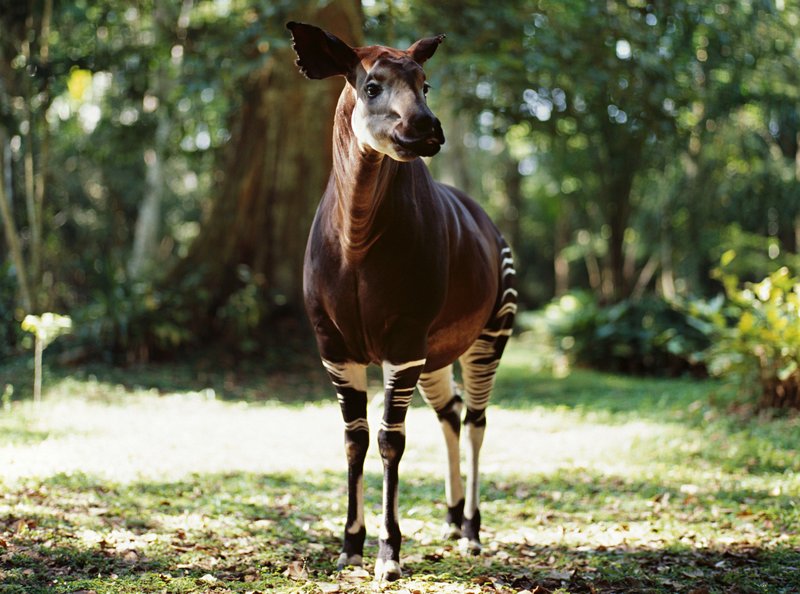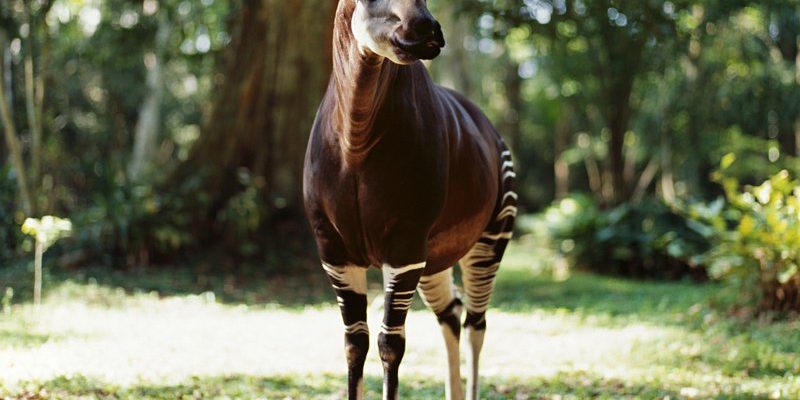
Imagine walking through a dense, leafy forest where the sunlight barely filters through the canopy. Suddenly, you spot a creature that seems to be part horse, part giraffe, and part zebra. You’re not dreaming! You’re staring at an Okapi, one of nature’s most intriguing animals. Often referred to as the “forest giraffe,” the Okapi has unique features that make it unlike any other animal on Earth. Despite its close relation to the giraffe, the Okapi is more than just an odd-looking version of its taller cousin.
Native to the rainforests of the Democratic Republic of Congo, these animals are masters of camouflage. Their dark, rich brown coats help them blend seamlessly into their surroundings, making them difficult to spot in the wild. If you’ve ever been fascinated by animals that seem to hide in plain sight, the Okapi is a prime example. Let’s take a deeper dive into their world, exploring their characteristics, habitat, behavior, and the conservation efforts surrounding these beautiful creatures.
Physical Characteristics
The Okapi is a true marvel of evolution. Standing about 4 to 5.5 feet tall at the shoulder, these animals have a body structure that is reminiscent of a horse, but their long necks and large, expressive eyes echo the giraffe. One of the Okapi’s most distinctive features is its striking legs, which sport bold, zebra-like stripes. This unique coloration not only adds to their charm but also provides a form of camouflage in the dappled light of their forest habitat.
Behaviorally, Okapis are solitary creatures, often roaming alone or in small, loosely-knit groups. They have a sleek, smooth coat that helps them remain hidden from predators. An interesting aspect of their physiology is their large ears, which can rotate independently. This allows them to pick up sounds from different directions, an essential trait for staying alert in the jungle’s dense underbrush. When it comes to their tongue, it’s a remarkable tool—long and prehensile, it helps them groom themselves and reach leaves and buds high up in the trees.
Another fascinating element of their physical makeup is their unique foot structure. The Okapi’s hooves are broader than those of a typical giraffe, which assists in walking through muddy or uneven terrain. Not just built for beauty, these features ensure the Okapi is well-adapted to life in the dense, moist rainforest of the Congo.
Habitat and Range
Okapis make their home primarily in the tropical rainforests of the Democratic Republic of Congo. These forests are rich and lush, filled with a variety of trees, plants, and wildlife. However, they’re also one of the most endangered ecosystems in the world, primarily due to human activities. Logging, mining, and agricultural expansion are putting immense pressure on the Okapi’s habitat. Despite being elusive, they rely heavily on the forest for food and shelter.
The dense vegetation not only provides food, such as leaves, fruits, and flowers, but also offers essential protection from predators. Generally, Okapis prefer areas that are characterized by a thick understory, where they can easily vanish from sight when predators approach. To thrive, they need a diverse range of flora, as their diet consists mainly of leaves from various tree species, along with shrubs and herbs. These preferences highlight how crucial it is to preserve their natural habitat.
Currently, the Okapi’s range is limited to a small portion of Central Africa. Conservation efforts are vital to ensure their survival, including protecting their habitat and implementing wildlife corridors to allow for movement and genetic diversity. It’s fascinating, and at the same time concerning, to think about how the future of this beautiful animal is tightly linked to the health of their forest home.
Diet and Feeding Habits
When it comes to dietary choices, the Okapi is a herbivore. They primarily feed on leaves, buds, and fruits found in their forest environment. Their long tongues, which can extend up to 12 inches, play a crucial role in their feeding habits. With this remarkable tongue, they can reach high into the trees or pull down branches to access fresh leaves. It’s as if they have their own built-in tool for foraging!
Interestingly, the Okapi’s diet is not just limited to what is readily available; they’re known to be selective eaters. They tend to prefer certain types of vegetation that provide the best nutrition. This selectivity is essential for their health, as it allows them to get the right balance of nutrients. Moreover, the Okapi has a unique digestive system that helps them derive the maximum nutritional value from their fibrous diet.
In the wild, Okapis typically spend a significant portion of their day foraging. They use their keen sense of smell to identify ripe fruits and fresh leaves. You might even catch them munching on a variety of plants that are toxic to many other species, showcasing their specialized digestive adaptations. This ability to utilize a diverse diet is an essential part of their ecological role within their habitat.
Behavior and Social Structure
Okapis are primarily solitary animals, which is quite different from the social structure of their giraffe relatives. They are known to have a home range that can vary significantly based on food availability and environmental conditions. While they may sometimes be seen together, it’s usually fleeting, as they prefer their own company. This solitary nature might seem odd, but it works perfectly for their lifestyle as they navigate the dense forest.
Communication among Okapis is subtle but fascinating. They use vocalizations, body language, and even scent marking to communicate with each other. The sounds they produce range from low grunts to high-pitched whistles. These noises serve various purposes, such as signaling danger or attracting a mate. If you’re ever lucky enough to observe these creatures in the wild, listen closely for their distinct calls!
During mating season, which typically occurs in the late summer, male Okapis can be seen displaying their strength and agility in hopes of attracting a female. While they do not form long-lasting bonds, the courtship rituals can be quite elaborate. After a gestation period of about 15 months, a single calf is born, and the mother takes on the role of caregiver, often hiding the young in dense vegetation to protect it from predators until it’s strong enough to join her.
Conservation Status
The Okapi is currently classified as endangered on the IUCN Red List. Their population has faced significant declines over the years due to habitat loss and poaching. The forests of the Democratic Republic of Congo are shrinking, and as a result, the Okapi’s natural habitat is disappearing. Without immediate action, these beautiful creatures may face extinction.
Conservation efforts are underway, with several organizations working hard to protect both the Okapi and its environment. Initiatives include creating protected areas, conducting research to monitor populations, and raising awareness about the importance of these animals. Local communities are also being engaged in conservation strategies, as their involvement is crucial for long-term success.
Moreover, education plays a vital role in these efforts. By informing people about the significance of the Okapi and the threats they face, conservationists hope to foster a sense of stewardship within local populations. After all, when people understand the value of wildlife in their ecosystem, they are more likely to take action to protect it.
Interesting Facts about the Okapi
| Common Name: | Okapi |
| Scientific Name: | Okapia johnstoni |
| Weight: | 600-800 pounds |
| Height: | 4.5-5.5 feet at the shoulder |
| Diet: | Herbivore (leaves, fruits, buds) |
| Lifespan: | 20-30 years in the wild; up to 40 years in captivity |
| Habitat: | Tropical rainforests in the Democratic Republic of Congo |
| Relative: | Giraffe |
FAQ
What is an Okapi’s closest relative?
Interestingly, the Okapi’s closest living relative is the giraffe. While they look quite different, genetic studies have shown that they share a common ancestor. Both belong to the Giraffidae family, yet the Okapi has adapted to a completely different habitat and lifestyle compared to its taller cousin.
Are Okapis good swimmers?
Yes, Okapis can swim! Although they mostly inhabit dense forests, they can cross rivers and streams when necessary. Their sturdy legs and strong bodies make them capable swimmers, which can be advantageous in their natural habitat when avoiding predators or accessing food sources.
What do Okapis communicate about?
Okapis have various vocalizations they use to communicate with one another, particularly during the mating season. They may grunt, whistle, or make other sounds to signal their presence or attract mates. Additionally, they communicate through body language and scent marking to establish territory and interact with other Okapis.
How long is an Okapi’s gestation period?
The gestation period for an Okapi is about 15 months. Once the female gives birth, she typically hides the calf in dense vegetation to protect it from potential predators. The mother will frequently return to nurse the calf, ensuring it remains safe and nourished during its early vulnerable months.
What is the current conservation status of Okapis?
Okapis are currently classified as endangered due to habitat loss and poaching. Conservation organizations are actively working to protect their habitat and monitor their populations to ensure their survival. Awareness and education about the Okapi’s plight are essential for successful conservation efforts.
Can Okapis be kept in captivity?
Yes, Okapis can be kept in captivity, and they have been successfully bred in several zoos around the world. However, it’s important that they have a habitat that mimics their natural environment as closely as possible. This includes providing ample space, appropriate foliage for feeding, and opportunities for social interaction with other Okapis.
What is the Okapi’s primary diet?
Okapis are herbivores that primarily consume leaves, fruits, and buds found in their forest environment. Their digestive systems are adapted to extract nutrients from the fibrous plants they eat, and they are known to be selective feeders, preferring certain varieties of vegetation for optimal nutrition.
How fast can Okapis run?
Okapis are not particularly known for their speed but can reach short bursts up to 30 miles per hour when necessary, particularly if they feel threatened by a predator. Their agility in navigating through thick forest underbrush is more critical than outright speed, allowing them to evade danger effectively.
Why are Okapis sometimes called ‘forest giraffes’?
Okapis are often referred to as ‘forest giraffes’ due to their close genetic relationship with giraffes. Despite their distinctive appearance, the anatomical similarities between the two—especially in their long necks and body structure—lead to this nickname. However, their lifestyle and habitat are quite different from those of the more well-known giraffe.
Where can I see an Okapi in the wild?
To see Okapis in the wild, your best bet is to venture into the tropical rainforests of the Democratic Republic of Congo. However, they are elusive creatures, and spotting them can be quite challenging. If a trip to Africa isn’t in your cards, many zoos and wildlife sanctuaries around the world have Okapis where you can learn more about these fascinating animals up close.
Are Okapis endangered?
Yes, Okapis are classified as endangered. Their populations are declining due to habitat destruction and poaching. Efforts are being made by various conservation groups to protect these animals and their habitats. Supporting these initiatives is vital for ensuring the survival of the Okapi in the wild for future generations.

